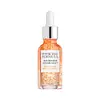What's inside
What's inside
 Key Ingredients
Key Ingredients

 Benefits
Benefits

 Concerns
Concerns

 Ingredients Side-by-side
Ingredients Side-by-side

Water
Skin ConditioningButylene Glycol
HumectantNiacinamide
SmoothingGlycerin
HumectantAcetyl Glucosamine
Skin ConditioningPentylene Glycol
Skin Conditioning1,2-Hexanediol
Skin ConditioningCaprylyl Glycol
EmollientCarbomer
Emulsion StabilisingDisodium EDTA
Dipotassium Glycyrrhizate
HumectantPhenylethyl Resorcinol
AntioxidantCaesalpinia Spinosa Fruit Extract
Skin ProtectingSodium Hydroxide
BufferingChondrus Crispus Extract
Skin ConditioningSodium Benzotriazolyl Butylphenol Sulfonate
UV Absorber3-O-Ethyl Ascorbic Acid
Skin ConditioningCI 77492
Cosmetic ColorantTocopheryl Acetate
AntioxidantPhenoxyethanol
PreservativeCollagen
MoisturisingAgar
MaskingCalcium Alginate
MaskingXanthan Gum
EmulsifyingKappaphycus Alvarezii Extract
Skin ConditioningHydroxyacetophenone
AntioxidantGlucosyl Hesperidin
HumectantLeuconostoc/Radish Root Ferment Filtrate
AntimicrobialSodium Hyaluronate
HumectantTropolone
Skin ConditioningGluconolactone
Skin ConditioningGlycyrrhiza Glabra Root Extract
BleachingCynara Scolymus Leaf Extract
Skin ConditioningCI 73360
Cosmetic ColorantSodium Benzoate
MaskingWater, Butylene Glycol, Niacinamide, Glycerin, Acetyl Glucosamine, Pentylene Glycol, 1,2-Hexanediol, Caprylyl Glycol, Carbomer, Disodium EDTA, Dipotassium Glycyrrhizate, Phenylethyl Resorcinol, Caesalpinia Spinosa Fruit Extract, Sodium Hydroxide, Chondrus Crispus Extract, Sodium Benzotriazolyl Butylphenol Sulfonate, 3-O-Ethyl Ascorbic Acid, CI 77492, Tocopheryl Acetate, Phenoxyethanol, Collagen, Agar, Calcium Alginate, Xanthan Gum, Kappaphycus Alvarezii Extract, Hydroxyacetophenone, Glucosyl Hesperidin, Leuconostoc/Radish Root Ferment Filtrate, Sodium Hyaluronate, Tropolone, Gluconolactone, Glycyrrhiza Glabra Root Extract, Cynara Scolymus Leaf Extract, CI 73360, Sodium Benzoate
Water
Skin ConditioningPropylene Glycol
HumectantAscorbic Acid
AntioxidantGlycerin
HumectantVitis Vinifera Seed Oil
EmollientDimethicone
EmollientXanthan Gum
EmulsifyingPolyacrylamide
C13-14 Isoparaffin
EmollientSodium Benzoate
MaskingPotassium Sorbate
PreservativeLaureth-7
EmulsifyingCitrus Aurantium Dulcis Peel Oil
MaskingLimonene
PerfumingSodium Hydroxide
BufferingCitral
PerfumingLinalool
PerfumingCI 77891
Cosmetic Colorant
 Reviews
Reviews

Ingredients Explained
These ingredients are found in both products.
Ingredients higher up in an ingredient list are typically present in a larger amount.
Glycerin is already naturally found in your skin. It helps moisturize and protect your skin.
A study from 2016 found glycerin to be more effective as a humectant than AHAs and hyaluronic acid.
As a humectant, it helps the skin stay hydrated by pulling moisture to your skin. The low molecular weight of glycerin allows it to pull moisture into the deeper layers of your skin.
Hydrated skin improves your skin barrier; Your skin barrier helps protect against irritants and bacteria.
Glycerin has also been found to have antimicrobial and antiviral properties. Due to these properties, glycerin is often used in wound and burn treatments.
In cosmetics, glycerin is usually derived from plants such as soybean or palm. However, it can also be sourced from animals, such as tallow or animal fat.
This ingredient is organic, colorless, odorless, and non-toxic.
Glycerin is the name for this ingredient in American English. British English uses Glycerol/Glycerine.
Learn more about GlycerinSodium Benzoate is a preservative. It's used in both cosmetic and food products to inhibit the growth of mold and bacteria. It is typically produced synthetically.
Both the US FDA and EU Health Committee have approved the use of sodium benzoate. In the US, levels of 0.1% (of the total product) are allowed.
Sodium benzoate works as a preservative by inhibiting the growth of bacteria inside of cells. It prevents the cell from fermenting a type of sugar using an enzyme called phosphofructokinase.
It is the salt of benzoic acid. Foods containing sodium benzoate include soda, salad dressings, condiments, fruit juices, wines, and snack foods.
Studies for using ascorbic acid and sodium benzoate in cosmetics are lacking, especially in skincare routines with multiple steps.
We always recommend speaking with a professional, such as a dermatologist, if you have any concerns.
Learn more about Sodium BenzoateSodium Hydroxide is also known as lye or caustic soda. It is used to adjust the pH of products; many ingredients require a specific pH to be effective.
In small amounts, sodium hydroxide is considered safe to use. However, large amounts may cause chemical burns due to its high alkaline.
Your skin has a natural pH and acid mantle. This acid mantle helps prevent harmful bacteria from breaking through. The acid mantle also helps keep your skin hydrated.
"Alkaline" refers to a high pH level. A low pH level would be considered acidic.
Learn more about Sodium HydroxideWater. It's the most common cosmetic ingredient of all. You'll usually see it at the top of ingredient lists, meaning that it makes up the largest part of the product.
So why is it so popular? Water most often acts as a solvent - this means that it helps dissolve other ingredients into the formulation.
You'll also recognize water as that liquid we all need to stay alive. If you see this, drink a glass of water. Stay hydrated!
Learn more about WaterXanthan gum is used as a stabilizer and thickener within cosmetic products. It helps give products a sticky, thick feeling - preventing them from being too runny.
On the technical side of things, xanthan gum is a polysaccharide - a combination consisting of multiple sugar molecules bonded together.
Xanthan gum is a pretty common and great ingredient. It is a natural, non-toxic, non-irritating ingredient that is also commonly used in food products.
Learn more about Xanthan Gum